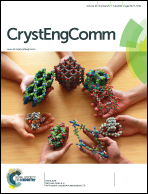Metal ion-mediated synthesis and shape-dependent magnetic properties of single-crystalline α-Fe2O3 nanoparticles†
Abstract
A facile and effective hydrothermal process for the controllable synthesis of uniform single-crystalline hematite (α-Fe2O3) nanoparticles with different shapes is presented. The morphology of the α-Fe2O3 products can be controlled through simply adjusting the metal ions additive. The effects of the different metal ions (atomic number from 25–30) on the size and morphology of the products were investigated. The cubic and thorhombic α-Fe2O3 particles can be generated by adding zinc ions and copper ions to the reaction mixture, respectively. For providing some insight into the correlation between the morphology and physicochemical properties, the magnetic properties of the as-obtained cubic and thorhombic α-Fe2O3 products were investigated. Interestingly, the cubic α-Fe2O3 products exhibited a superparamagnetic properties at T = 300 K. In contrast, the thorhombic α-Fe2O3 products displayed ferromagnetic and low-temperature phase transition behaviours at room temperature. The fundamental understanding of crystal-phase and morphology-tunable nanostructures that are enclosed by shape-dependent magnetic properties is expected to direct the design and development of highly efficient magnetic nanomaterials.


 Please wait while we load your content...
Please wait while we load your content...